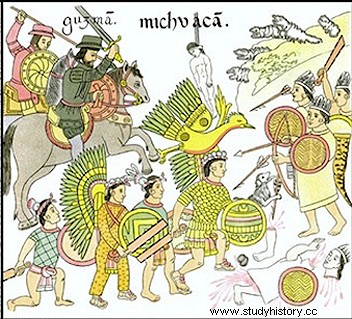According to scientists, an epidemic of salmonellosis could have been mainly responsible for the disappearance of populations from Mexico around 1540.

19th century illustration depicting the meeting of Hernan Cortez and Emperor Moctezuma in the 16th century.
Chance of the calendar, in the midst of the Lactalis contaminated infant formula, a study published on January 15, 2018 in the journal Nature, Ecology and Evolution shows that a salmonella is most certainly at the origin of one of the deadliest epidemics in the history of humanity which decimated the pre-Columbian civilization between 1545 and 1550. Work which had already been published in the journal online bioRxiv and that Science and Future made you discover in February 2017.
COCOLIZTLI. This is what the Aztecs of central Mexico called the terrible epidemics that decimated them after the arrival of the Spanish conquerors in 1519. A hotly debated subject among historians who have been searching for decades to know the exact origin and nature of these plagues that fell on these peoples. One of them has just been identified by geneticists from the Max-Planck Institute for the History of Science in Jena (Germany).
Salmonella responsible for the disappearance of 80% of the population of Mexico?
In an article published in the online journal bioRxiv , Johannes Krause and his team believe they have discovered for the first time direct evidence that one of these strains brought from Europe, a Salmonella (Paratyphi C), could be, according to them, the cause of the disappearance of 80% of the population of Mexico! A spectacular demographic collapse signaling the end of the Aztec Empire. These results were obtained after the sequencing of bacterial DNA taken from 29 individuals found in a cemetery in Teposcolula-Yucundaa, in Oaxaca, in the south of the country. They attest to the presence - except in five cases - of a fatal enteric fever between 1545 and 1550.

Illustration of salmonella. Credits:Rocky Mountain Laboratories, NIAID, NIH, Wikimedia
When the Spaniards arrived, headed by Hernan Cortés, researchers estimate that the population of Mexico was then around 25 million. A century later, after a long series of epidemics and battles, there were only a million left! "Two large cocoliztli in 1545 and 1576 would have decimated from 7 to 18 million people in the highlands ", we read in the journal Nature who has devoted an article to this publication*.
The trail of salmonellosis is not unanimous among Aztec specialists
But these announcements are not unanimous. Joined by Sciences et Avenir , Michael E. Smith of Arizona State University (United States), one of the best specialists of the Aztecs, finds these conclusions excessive:"We know that there was a series of serious epidemics throughout the 16th century, he explains. But salmonella is in no way responsible for the disappearance of Aztec society! It had already disappeared a long time ago! The authors of these analyzes also fix them the origin of this epidemic around 1545 when the conquest and destruction of the Aztecs took place in 1519-1521, 25 years earlier! With already a scourge, smallpox:"An outbreak of smallpox brought by the Spanish in 1520 contributed to the downfall of the Aztec capital of Tenochtitlan ( ancient Mexico), August 13, 1521".
This is confirmed by Grégory Pereira, director of the Department of Archeology of the Americas, (UMR 8096 of the Cnrs), at the University of Paris 1- Panthéon Sorbonne, recalling for example that the penultimate ruler Tarasque - kingdom covering the current state of Michoacan - had died of smallpox before he had even met the first Spaniard! Which gives an idea of the rapidity of these epidemics:during the siege of Mexico City, two Aztec emissaries had indeed come to ask him for help to fight the Spaniards, unwittingly transmitting the deadly virus to him. "This new salmonella study is probably correct in identifying these bacteria as the main component of the cocoliztli of 1545, but it has nothing to do with the destruction of Aztec society that took place in the very first years of contact. !"


Images of the conquest of Mexico and its violence, taken from the Lienzo de Tlaxcala, a 16th century manuscript produced by allies of the Spaniards, sworn enemies of the Aztecs. This document was brought back to Spain in 1552. It was with these coalitions of peoples adversaries of the Aztecs that Cortèz succeeded in destroying this empire Credit:Lienzo de Tlaxcala
Conquest . When Cortès landed in Mexico in 1519, he was not the first European to set foot on the peninsula. It has already been preceded by two Spanish exploratory expeditions, those of Hernan de Cordoba and Juan de Grivalja. On the other hand, during his trip, Cortès will discover a handful of Castilian survivors of shipwrecks, taken prisoner a few years earlier by Indian caciques. This means that in terms of germ exchange, pathologies reported from Europe had already begun to penetrate and spread to Mesoamerica much earlier. Not to mention the expeditions that began in 1500 on the side of Colombia and Panama, nor the zoonoses transported by dogs, horses and other animals brought back from Europe in the holds of caravels by the Conquistadors.
*“Collapse of Aztec society linked to catastrophic salmonella outbreak ”, Nature, February 16, 2017
